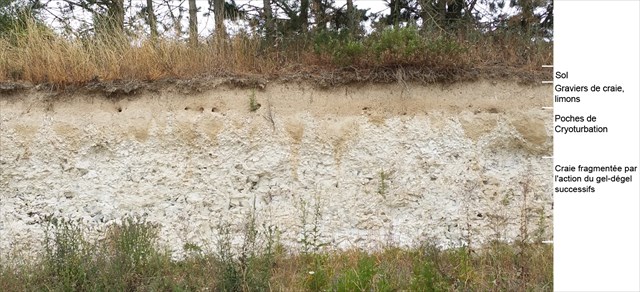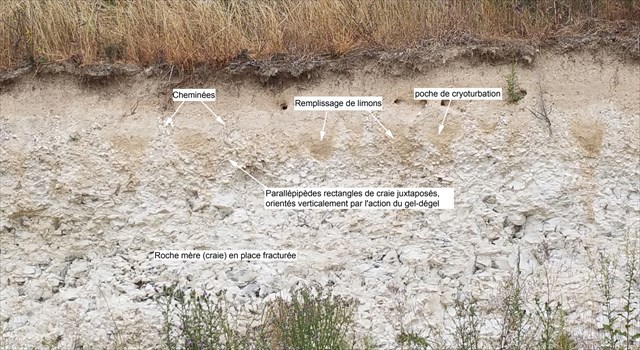Français :
Glaciations du Quaternaire :
Les climats périglaciaires lors des phases froides du Quaternaire ont englobé la plus grande partie de l’Europe, depuis le massif central et le bassin parisien jusqu’à l’Ukraine, ils ont modelé nos paysages actuels.

L’Europe au maximum Würmien (Dernière grande glaciation du Quaternaire entre 75 000 et 20 000 ans BP)
Pendant cette période, les sols ont subi un gel permanent appelé pergélisol (permafrost). Le pergélisol reste constamment induré par la glace interstitielle, il fige les parties profondes du sol en un béton imperméable. Sa profondeur peut atteindre plusieurs dizaines voir centaines de mètres. Lors du réchauffement saisonnier, un dégel progressif s’opère depuis la surface faisant fondre quelques mètres de la partie supérieure, c’est la couche active (mollisol) souvent saturée d’eau. L’alternance des phases de gel et de dégel saisonniers provoque alors la formation de figures sédimentaires, typique des paysages de Toundra en milieu périglaciaire.
L’importance du gel dans le façonnement des paysages est considérable, c’est un puissant agent d’érosion. Les oscillations climatiques quaternaires ont laissé une empreinte durable dans les sols.
Le processus de cryoturbation :
Cryoturbation du grec cruos : froid, et du latin turbatio : trouble. La cryoturbation est un remaniement mécanique des couches superficielles du sol. Lors des périodes de gel, l'eau contenue dans le sol en se solidifiant, occupe un volume plus important et déplace les matériaux. Les alternances de gel et de dégel saisonniers provoquent des pressions capables de déformer les matériaux meubles de la couche active. Les mouvements de cryoturbation créent des cellules de convection dans le sol.
Les sols périglaciaires sont brassés et leurs constituants sont triés selon leur résistance physique aux mouvements lents dus aux alternances de gel-dégel. Ces déplacements sont à l'origine de la formation de sols dits structurés, caractérisés par un tri des particules selon leur taille.

Formation des sols cryoturbés (d’après Van Vliet-Lanoë 1988)
Les poches de cryoturbation :

Affleurement de la carrière de Courtisol
La craie est un matériau très sensible aux variations du climat, roche gélive elle se pulvérise sous l’action de fortes différences thermiques. Lorsqu’un sédiment fin, comme un limon issu de la désagrégation de la craie, recouvre un cailloutis crayeux sur une pente faible, le limon gèle très vite et forme un béton de glace qui, par gonflement cryogénique, exerce une pression sur le cailloutis qui est éjecté vers la surface. Chaque cycle soulève les pierres de quelques centimètres pour venir entourer les fractions limoneuses. Les matériaux sont donc tributaires de leur capacité à absorber l’eau dont le volume va s’accroitre durant la phase de gel.
Les poches de cryoturbation sont très riches en fractions limoneuses fines de couleur jaunâtre, elles sont séparées par des cheminées composées de fragments de craie sub-arrondis et redressés verticalement.

Détails de l’affleurement
En surface la ségrégation des cailloux et des éléments fins engendre des sols structurés, ce sont des cercles de pierres au centre limoneux. Ce phénomène est responsable de la formation des cryosols tel que les sols polygonaux ou les roses de pierres.

Exemple de sols polygonaux présentant un motif en cercle de pierre en surface
Questions :
Envoyez-moi vos propositions de réponses soit via Mon profil GC soit via la messagerie geocaching.com (Message Center), puis loguez cette cache "Found it". Je vous contacterai au besoin.
Q1.Comment appelle-t-on le phénomène responsable de la fragmentation mécanique de la craie par l’action des cycles gel-dégel successifs? Expliquez le processus (ce n’est pas la cryoturbation).
Q2.Estimez la profondeur des poches de cryoturbation face à vous et leur diamètre moyen (cm).
Q3. Actuellement, dans quelles régions du monde peut-on encore observer le processus de cryoturbation en action ? Sachant qu’il a lieu uniquement en milieu périglaciaire.
Q4. Citez un autre exemple de formation superficielle célèbre, héritée des grandes glaciations quaternaires en Europe.
Q5. (facultatif mais souhaité) prenez une photo de votre GPS ou de vous-même aux coordonnées de la EarthCache.
English :
Quaternary glaciations:
Periglacial climates during the cold phases of the Quaternary have included the major part of the Europe, from the Massif Central mountains and the Parisian Basin until Ukraine, they have shaped our current landscapes.

Europe during the Würmian period (Last Quaternary ice age between 75 000 and 20 000 years BP)
During this period, the soils have suffered a permanent gel called permafrost. Permafrost remains constantly indurated by interstitial ice, it freezes the deeper parts of the soil in an impermeable concrete. Its depth can reach several tens or hundreds meters. During the seasonal warming, a gradual thaw occurs a gradual thaw occurs from the surface melting few meters from the upper part of the soil, this is the active layer often saturated with water.
The alternation of freeze phases and then seasonal thaw leads to the formation of sedimentary figures, typical landscapes of tundra in periglacial environment. The importance of the freeze in landscape creation is considerable, this is a powerful agent of erosion. Quaternary climatic oscillations have left a lasting imprint in the soil.
Cryoturbation process:
Cryoturbation is in greek : cruos cold, and in Latin : turbatio disorder.Cryoturbation is a mechanical reworking of the surface layers of the soil. During freezing periods, the water contained in the soil is solidified. The ice occupies a larger volume and moves the materials. Freeze-thaw alternations cause pressures which can deform the soft material of the active layer. The cryoturbation movements create convection cells in the soil. Periglacial soils are wiggled and materials are sorted according to their physical strength to low movements, due to freeze-thaw alternations. These movements are responsible for the formation of structured soils, characterized by a particle sorting according to their size.

cryoturbated soils formation (after Van Vliet-Lanoë 1988)
Cryoturbation lobes:

Outcrop in the open pit career of Courtisol
Chalk is a very sensitive material to climate variations, this frost-shattered limestone is sprayed under the action of temperature differences. When fine sediment, like silt resulting from the chalk weathering, covering chalky gravel on a slight slope, silt quickly freezes and forms an ice concrete which by cryogenic swelling increases the pressure on the gravel that is ejected towards the surface. Each cycle raises the stones a few centimeters until surround the silty fractions. Therefore, materials are highly dependent on their ability to absorb water, the volume will increase during the freeze phase.
The cryoturbation lobes are filled of silty sediments of yellowish color, they are separated by chimneys composed of sub-rounded fragments of chalk straightened vertically.

Outcrop details
On the surface, pebbles and fine elements generates structured soils corresponding to stone circles with a silty center. This phenomenon leads to the formation of cryo-soils as polygonal soils.

Example of polygon soils having a pattern of stone circle
Questions :
Send your answers to my Mon profil GC or to the Message Center, then you can log "Found it". I will contact you if necessary.
Q1. How do you call the phenomenon responsible for the mechanical fragmentation of the chalk by the action of successive freeze-thaw cycles? Explain the process (not cryoturbation).
Q2. Estimate the depth of cryoturbation lobes in front of you and their average diameter (cm).
Q3. Currently, in which regions of the world can we still observe the cryoturbation process in action? Knowing that only takes place in periglacial environment.
Q4. Give another example of periglacial landform, herited of the Quaternary glaciations in Europe.
Q5. (optional but desired) take a picture of your GPS or yourself at the coordinates of the EarthCache.
Sources bibliographiques /References :
https://fr.wikipedia.org/wiki/Cryoturbation
http://paleotapho.org/periglaciaire/limpact-des-sols-tries-periglaciaires-b-masson-l-vallin/
http://eusoils.jrc.ec.europa.eu
Géomorphologie de la France. 2013, Dunod, Paris, 271p
Amat, Dorize, Le Cœur. 2002, Eléments de Géographie Physique, collection grand amphi de géographie , Bréal, 447p
Chaput, 2006. Initiation à la géomorphologie, Universités géographie, Ellipses, 172p
Demangeot, 2006. Les milieux naturels du globe, Armand Colin, 364p